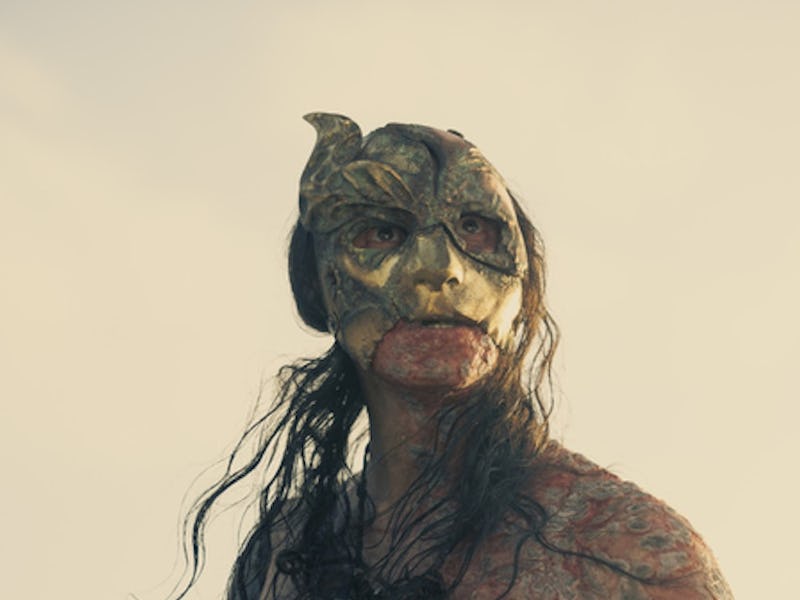House of the Dragon’s best Easter egg could change Game of Thrones canon
The Crabfeeder and his soldiers don some golden masks we have seen before in Game of Thrones.

Not even a villain who feeds his victims to carnivorous crabs is a match for a rogue prince and his dragon. House of the Dragon fans were delighted by the rise (and fall) of Craghas Crabfeeder, and one tiny Easter egg in Episode 3 could be more important than you think — it might even change Game of Thrones history!
Warning! Spoilers ahead for House of the Dragon Episodes 1-3.
In Episode 3 of House of the Dragon, we witness Craghas “Crabfeeder” Drahar (Daniel Scott-Smith) and his Triarchy armies razed to ash by Corlys Velaryon (Steven Toussaint), his Driftmark warriors, and Daemon Targaryen’s (Matt Smith) battalion. The resulting victory leads to the end of high sea-trade taxes imposed on King’s Landing or Driftmark, and to Daemon declaring himself King of the Stepstones and the Narrow Sea.
Craghas “Crabfeeder” Drahar in House of the Dragon.
But, perhaps more importantly, viewers noted something curious and familiar about the Crabfeeder and his supporters’ armor: golden human-bird-hybrid masks that look much like the ones worn by an anti-Daenerys organization known as the Sons of the Harpy in Game of Thrones. Crabfeeders’ actor confirmed in an interview with Entertainment Weekly that, yes, this is the same disguise the Sons of the Harpy don in Seasons 5 and 6.
In House of the Dragon’s TV predecessor and in the George R.R. Martin-penned A Song of Ice and Fire books, the Sons of the Harpy are formed in response to Daenerys. Could the prequel show have confirmed preexisting origins for the group? Let’s dive in.
Who are the Sons of the Harpy in Game of Thrones?
The Sons of the Harpy made their first appearance in Season 5 of Game of Thrones— or so we thought!
The Sons of the Harpy are slightly changed on-screen for Game of Thrones from their A Song of Ice and Fire origins. We’ll be sticking with explaining their presence in GoT — and potentially House of the Dragon — for now.
The Sons of the Harpy, also known as Harpy’s Sons, were formed after Daenerys Targaryen (Emilia Clarke) conquers Meereen, the largest of the three great Slaver Cities of Slaver’s Bay, in an effort to break the slave trade and to live up to her self-given title of “Breaker of Chains.” The harpy, a human-vulture creature with roots in Ancient Greek mythology, is the emblem of all three Slaver Cities.
Sons of the Harpy take on Grey Worm.
The Sons of the Harpy begin to frustrate Daenerys when they start murdering members of the Unsullied, the “independent” super-soldier-eunuchs who follow her commands. Daenerys initially tries to make peace with the ruling elite of Meereen in order to quell the Sons of the Harpy’s sabotage. These efforts do not work, and the Sons of the Harpy mount mass attacks that take out both Unsullied and civilians. The Harpy’s attempts to capture Daenerys are futile, however, as she escapes atop her dragon.
The Sons of the Harpy continue to wreak havoc in the following season. In disguise, they plot against Daenerys and set fire to every ship in Meereen’s harbor. Eventually, it’s revealed they are funded by the slaveholders of Yunkai and Astapor, the two other Slaver Cities, as well as Volantis, the only Free City of Essos that (ironically) practices slavery. Peace is negotiated, but soon a treaty is broken. Daenerys comes down on the Sons of the Harpy not only with the full wrath of Drogon but also her Dothraki horde and Daario Naharis (Michiel Huisman). The Sons of the Harpy are overpowered, and Daenerys regains control of Meereen.
Were the Sons of the Harpy inspired by the Crabfeeder’s army?
The Crabfeeder and his armies at the Stepstones met a brutal end at the hands (or rather, blaze) of Prince Daemon and his dragon, Caraxes, in Episode 3 of House of the Dragon.
Nowhere in George R.R. Martin’s A Song of Ice and Fire prequel writings does it state that the Crabfeeder, or his armies in the Stepstones, are associated with the Sons of the Harpy. The Sons of the Harpy are referenced in the third “A Song of Ice and Fire,” A Storm of Swords, and appear in the fifth book, A Dance with Dragons, as a legitimate threat to Daenerys Targaryen’s plans of “liberation” and conquest. Their presence in the books aligns somewhat with their introduction in the HBO show. Viewers are led to believe the Sons of the Harpy are created directly in response to Daenerys’ occupation of Meereen, and that the organization has no prior history in Westeros.
House of the Dragon may have taken creative liberties (with the blessing of author Martin, who also co-created the HBO prequel and executive produces) to establish lore continuity between both show adaptations. It would make sense that the Sons of the Harpy, who despised Targaryen rule in Meereen, would derive some inspiration from the Crabfeeder and his Triarchy army, who opposed Daemon Targaryen (and Corlys Velaryon) upon the Stepstones in response to high-taxing. A decision to don the same masks may be a way to honor their “ancestors” in the fight against the House of the Dragon.
We may never know if the Sons of the Harpy masks were merely a cheeky GoT Easter Egg or if they were meant to fiddle with canon to put in place more connections between both franchise properties. But one thing is for sure: Targaryens have never been without enemies.
House of the Dragon airs Sundays at 9 on HBO and HBO Max.
This article was originally published on